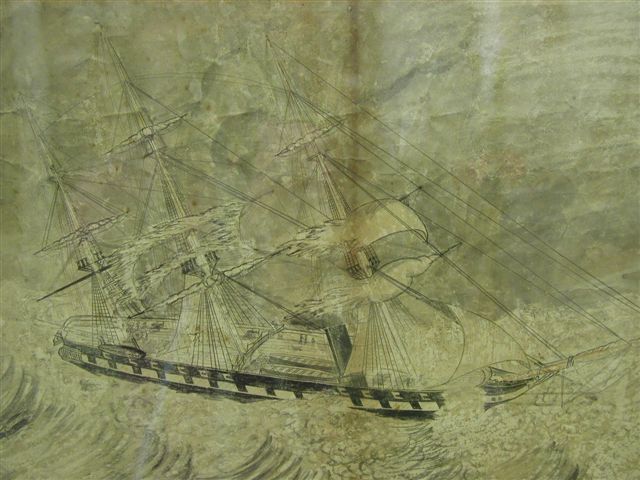► Royal Navy ► Varia
J. Tuckers drawing of HMS Emerald in a gale of wind in the North Atlantic Oct. 1861.
In october 1861 HMS Emerald encountered severe gales by the Newfoundland banks when transporting Armstrong guns and associated stores to Halifax for the ships of the North America and West India squadron. This pen and ink drawing - which shows the ship with the mizzen topgallant yard sent down, fore and main spencers set, while the main topsail has blown out its boltropes, and the same fate seems to be overtaking the fore topsail and brailed up foresail - was found in an antique shop on the Island of Nantucket, Massachusetts in 2001. It is signed "Drawn by J. Tucker H.M.S. Emerald" (John Tucker's career).
| "H.M.S. Emerald. 51. Guns In a gale of wind in the North Atlantic Oct. 1861." |
 |
 |
details |
 |
 |
 |
 |
From the Naval Intelligence section of the London Times
1 October 1861.
A number of Armstrong 100 and 30 pounder guns, with their fittings, shot, shell, &c. have been already set aside by the Ordanance authorities at Portsmouth for the service of the North America and West India squadron, and according to present arrangements, the Emerald, 51 screw, capt. A. Cumming, will at once embark the guns and stores apportioned to the Nile, St. George, and Cadmus, and sail with them to Halifax.
5 October 1861.
The Emerald, 50, screw, Capt. A. Cumming, under orders for Halifax, with Armstrong guns, shot, &c., for the West India squadron, embarked supernumeraries at Spithead yesterday. She is expected to leave before daylight this morning.
7 October 1861
The Emerald, 50, screw, Capt. A. Cumming, sailed from Spithead at mid-day on Sunday for Halifax, with Armstrong guns, stores, &c.
6 November 1861
The screw steam frigate Emerald, 51, capt. Arthur Cumming, which left Spithead October 5, with supernumeries for Halifax, put back damaged to Plymouth Sound yesterday morning, as reported in the second edition of the Times. She reached as far as the banks of Newfoundland, where she experienced very heavy weather, and was compelled to bear up for the Channel. The frigate has lost three quarter-boats, port davit, spare topsail yard, and other spars. She had her main yard sprung and sails split, stern post sprung, &c. The engines and machinery were so much damaged by the rolling of the ship that considerable time was occupied in getting under steam. Eleven days were occupied in returning to Plymouth. One marine had his leg broken by the shot which got adrift from the racks in the storm. The principals of the various departments connected with the Devonport Dockyard went at noon in the steamtug Pike to the Emerald in the Sound, to survey her defects. She will be taken into Hamoaze for repair without delay.
7 November 1861
The return of the Emerald, 51, to the Sound, after an ineffectual effort to reach Halifax, has created considerable interest among the naval community at Plymouth. It appears that the frigate, which left Spithead on the 5th of October, encountered on the 10th, 11th, 13th, and subsequently a succession of heavy gales from north-north-west to south-south-west, from the effects of which she was compelled on the 22d to put back, being then in lat. 48 N., and long. 37 W. During all this time there was excessive rolling, accelerated, it is said, by the weight of her armament. Although thoroughly caulked before departure, she leaked "like a sieve" after the first gale. Subsequently some of the beams and knees in the lower deck and the after sternpost were stared. The ship's pumps were broken, and the discharge pipe of the engines split, by which and other injuries they were several days in a disabled state, It is satisfactory to know that the crew continued well disciplined throughout the storm and its contingencies. The Emerald passed the Warrior and Revenge in the chops of the Channel on Monday night. Yesterday she got up steam, and, aided by the steamtugs Prospero and Zephyr, proceeded from the Sound into Hamoaze. It is conjectured that the Emerald will not now go to Halifax, but direct from Plymouth, to Vera Cruz.
This event tookplace several months after William Loney left Emerald in April 1861.
Top↑
 |